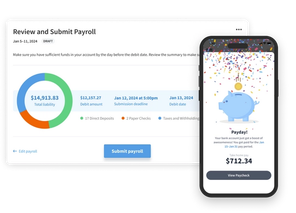
Eddy’s HR Mavericks Encyclopedia
The world's largest free encyclopedia of HR, with 700+ HR articles and podcasts.
Created by Eddy and our HR Mavericks community.
Additional Pay
There are a lot of reasons to supplement employee wages with additional pay. You may find yourself looking for ways to correct an error, show appreciation, improve performance, encourage participation in a program or sweeten the deal for a new hire.
Whatever the reason, knowing the different types of additional pay and how they serve the employment relationship is an important part of Human Resources management. This article will show you the basics of additional pay and when to use it like a pro!
Whatever the reason, knowing the different types of additional pay and how they serve the employment relationship is an important part of Human Resources management. This article will show you the basics of additional pay and when to use it like a pro!
What Is Additional Pay?
Additional pay is whatever compensation you give to an employee that is above or beyond their base hourly rate or salary. Examples of additional pay include wellness bonuses, overtime, payout of accrued time off and back pay.
Additional Pay Versus Base Pay
Base pay is the rate your employee agrees to for the regular work they do. An employee’s base pay is a fixed rate and can be hourly, weekly, monthly or yearly. Additional pay is any compensation that exceeds the rate your employee receives in exchange for their services. Unlike base pay, additional pay is a one-time or short-term adjustment.
Why You Might Issue Additional Payments to Employees
There are several reasons why you might issue additional pay to an employee. Some types of additional pay are required by law while others are optional or at the company’s discretion. Below are several examples of additional pay and why you might issue them to an employee.
- Overtime hours. When nonexempt, hourly employees work more than 40 hours in a week, the Fair Labor Standards Act (FLSA) requires that you pay them time and a half (1.5 times their base pay rate) for the additional hours.
- Additional responsibilities. If an employee takes on additional responsibilities for a time, you should compensate them appropriately for responsibilities outside of their job description.
- Bonuses. Offering a bonus as additional pay rewards employees for their contribution to the success of your business. Bonuses can be either a discretionary gift such as a holiday bonus or an expected part of employee compensation.
- Commission on sales. Paying employees commission on their sales creates an incentive to sell. Employees that make commission on sales might receive a percentage on a sale or a flat rate as additional pay.
- Unused time off. When an employee accrues time off but does not use it, you can pay out their time either as a severance after termination or as an alternative to rolling it over to the next year.
- Retroactive pay. If you miscalculate overtime, forget a pay raise, or forget a shift differential, you must correct the error with retroactive pay.
- Severance pay. When you terminate an employee, your state might require severance pay or you may opt to provide them with severance pay. The amount of severance pay depends on factors such as performance and tenure.
Topics

Amanda Davis
Amanda has spent over 10 years building a career in Human Resources in the non-profit sector. Her roles have included HR assistant, recruitment and onboarding coordinator, and manager of learning and professional development. Although Amanda enjoys her time as an HR consultant now, she prefers to use her experience to strengthen the field through the education and development of its practitioners.
Frequently asked questions
Other Related Terms
Eddy’s HR Mavericks Encyclopedia
Additional Pay
There are a lot of reasons to supplement employee wages with additional pay. You may find yourself looking for ways to correct an error, show appreciation, improve performance, encourage participation in a program or sweeten the deal for a new hire.
Whatever the reason, knowing the different types of additional pay and how they serve the employment relationship is an important part of Human Resources management. This article will show you the basics of additional pay and when to use it like a pro!
Whatever the reason, knowing the different types of additional pay and how they serve the employment relationship is an important part of Human Resources management. This article will show you the basics of additional pay and when to use it like a pro!
What Is Additional Pay?
Additional pay is whatever compensation you give to an employee that is above or beyond their base hourly rate or salary. Examples of additional pay include wellness bonuses, overtime, payout of accrued time off and back pay.
Additional Pay Versus Base Pay
Base pay is the rate your employee agrees to for the regular work they do. An employee’s base pay is a fixed rate and can be hourly, weekly, monthly or yearly. Additional pay is any compensation that exceeds the rate your employee receives in exchange for their services. Unlike base pay, additional pay is a one-time or short-term adjustment.
Why You Might Issue Additional Payments to Employees
There are several reasons why you might issue additional pay to an employee. Some types of additional pay are required by law while others are optional or at the company’s discretion. Below are several examples of additional pay and why you might issue them to an employee.
- Overtime hours. When nonexempt, hourly employees work more than 40 hours in a week, the Fair Labor Standards Act (FLSA) requires that you pay them time and a half (1.5 times their base pay rate) for the additional hours.
- Additional responsibilities. If an employee takes on additional responsibilities for a time, you should compensate them appropriately for responsibilities outside of their job description.
- Bonuses. Offering a bonus as additional pay rewards employees for their contribution to the success of your business. Bonuses can be either a discretionary gift such as a holiday bonus or an expected part of employee compensation.
- Commission on sales. Paying employees commission on their sales creates an incentive to sell. Employees that make commission on sales might receive a percentage on a sale or a flat rate as additional pay.
- Unused time off. When an employee accrues time off but does not use it, you can pay out their time either as a severance after termination or as an alternative to rolling it over to the next year.
- Retroactive pay. If you miscalculate overtime, forget a pay raise, or forget a shift differential, you must correct the error with retroactive pay.
- Severance pay. When you terminate an employee, your state might require severance pay or you may opt to provide them with severance pay. The amount of severance pay depends on factors such as performance and tenure.
Topics

Amanda Davis
Amanda has spent over 10 years building a career in Human Resources in the non-profit sector. Her roles have included HR assistant, recruitment and onboarding coordinator, and manager of learning and professional development. Although Amanda enjoys her time as an HR consultant now, she prefers to use her experience to strengthen the field through the education and development of its practitioners.
Frequently asked questions
Other Related Terms
Eddy's HR Newsletter
Sign up for our email newsletter for helpful HR advice and ideas.


